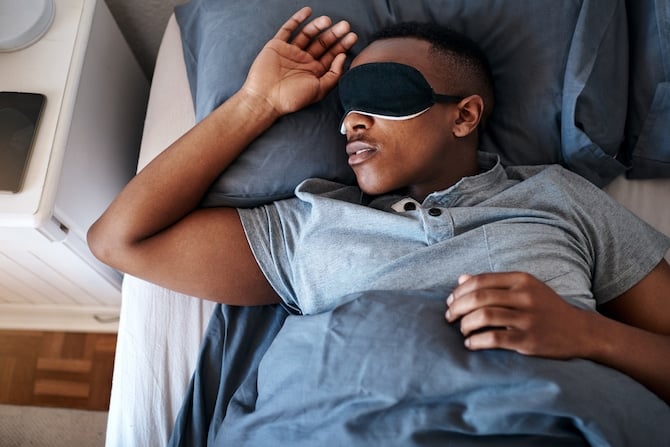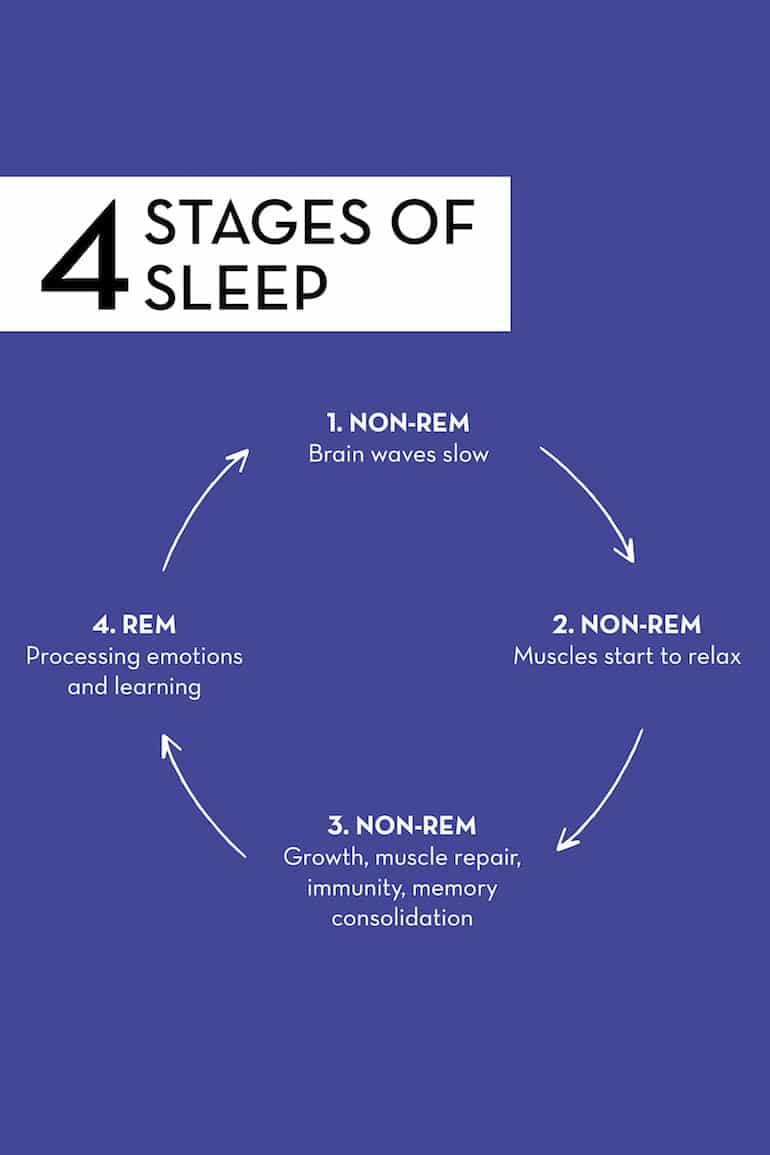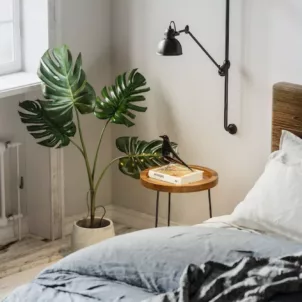You may not think of sleep as an active time in your day, but under the hood, your brain and body are hard at work repairing your muscles, processing emotions, consolidating memories, and strengthening your immune system. This work is done throughout the four stages of sleep, which make up one cycle of sleep.
Get to know sleep cycles, the stages of sleep, and how to make the most out of every night’s rest.
What Are Sleep Cycles?
Each cycle of sleep is around 90 minutes, and you ideally go through four to six sleep cycles at night, says Fariha Abbasi-Feinberg, MD, FAASM, medical director of sleep medicine at Millennium Physician Group in Fort Myers, Florida. That’s six to nine hours of sleep, which aligns with the National Sleep Foundation’s (NSF) recommendation that adults between 18 and 64 should aim for seven to nine hours of slumber each night.
One sleep cycle includes one stage of REM (rapid eye movement) sleep and three stages of non-REM (non-rapid eye movement) sleep. “The early part of the night usually has more non-REM sleep while cycles of REM sleep lengthen towards the second part of the night,” Dr. Abbasi-Feinberg explains.
About 45 to 50 percent of your night is spent during stage two non-REM sleep and 20 to 25 percent is in stage three non-REM sleep, says Abhinav Singh, MD, medical director for Indiana Sleep Center and member of the medical review panel at SleepFoundation.org.

If you’re sleep deprived, you’re not getting enough sleep cycles at night to feel refreshed in the morning. And when you are finally able to snooze, you tend to move through stages one and two more quickly and spend more time in stage three and REM sleep, Dr. Singh explains. In fact, you may experience the REM rebound effect, which causes you to spend more time in REM sleep. As a result, you might have longer and more intense dreams, according to Stat Pearls.
“Skimping on sleep on a regular basis can lead to a multitude of health problems, including weight gain, high blood pressure, heart disease, and stroke, as well as mood disorders,” Dr. Abbasi-Feinberg says.
What Are the Four Stages of Sleep?

Going through multiple sleep cycles at night is key to waking up feeling well-rested the next morning. But what happens within those cycles is just as important: Research shows that each stage of sleep also plays a specific role in maintaining your health.
“Non-REM sleep is important for growth, repairing muscles, and strengthening the immune system, while REM sleep is important in processing emotions,” Dr. Abbasi-Feinberg says. “A combination of REM and non-REM stage 3 sleep is needed for memory consolidation and learning.”
That said, you shouldn’t think about optimizing one stage of sleep over the other because they are all important. You need to cycle through each stage to reap all the benefits of sleep, Dr. Abbasi-Feinberg says.
So if you would like to reduce stress, boost your immunity, and improve your memory and problem-solving skills, you should focus on getting more quality sleep overall.
Here’s a breakdown of each stage of sleep and what they are each designed to do.
Non-REM Stage 1 Sleep
This is the lightest stage of sleep and usually lasts about seven minutes, per the NSF. You can wake up easily at this stage, so make sure to silence your smartphone and shut other electronic devices off.
“Your brainwaves start to slow down, and your breathing and eye movements start to change a bit,” Dr. Abbasi-Feinberg says. Your muscles also start to relax, but you may also have a feeling of falling and experience a muscle contraction known as motion hypnic myoclonic or hypnic jerk, or, twitching. Twitching in sleep isn’t anything to be concerned about.
Non-REM Stage 2 Sleep
At this point, your brain starts to create short bursts of electrical activity called sleep spindles, Dr. Abbasi-Feinberg says. “As you go through different stages of sleep, you usually cycle in and out of stage two sleep. Although this stage two is still light sleep, you’re less likely to be awakened, according to the NSF. You spend around 25 minutes in stage two sleep.
Non-REM Stage 3 Sleep
Also known as deep sleep and slow-wave sleep, stage three of non-REM sleep is characterized by very slow brainwaves, Dr. Abbasi-Feinberg says. It’s hard to wake someone up at this stage of sleep. “This stage is thought to be important for growth, muscle repair, immunity, and memory consolidation,” she says.
Researchers hypothesize that slow-wave sleep can help your immune system build memory to fight against pathogens your body previously encountered, according to an October 2015 article in Trends in Neurosciences. Sleep helps redistribute antigenic memories from antigen-presenting cells to T cells, which help protect your body from infection. This helps your body recognize when a virus or harmful bacteria is attacking the body so it can react.
At stage three non-REM sleep, muscles are also relaxed to help them repair. Human growth hormones are secreted, per Sleep.org, which helps your muscles build back stronger.
According to a January 2018 review in Sports Medicine, interventions to extend restful sleep have been shown to be beneficial for boosting sports performance in young athletes, including swimming, soccer, and basketball.
In terms of types of memory consolidation, such as declarative memory (remembering facts and events) and procedural memory (learning how to do something), research is still pending, Dr. Singh says.
“Research is still ongoing to understand the connection between specific sleep stages to exact memory types. We do have some direction but more needs to be ascertained,” he explains.
For instance, some studies have examined how slow-wave sleep and REM sleep may both play a role in processing and consolidating declarative and procedural memory. But generally speaking, non-REM sleep helps with learning, comprehending, encoding, archiving, and recalling.
Stage 4 REM Sleep
REM sleep is characterized by rapid eye movements from side to side and is important for processing emotions and learning. Dr. Singh says that the more detailed functions of REM sleep are lesser-known, but overall, it can help with creative and procedural memory and negative memory reconciliations.
At this stage, you have faster and more irregular breathing patterns and increased heart rate and blood pressure, according to the National Sleep Foundation. So your brainwaves look similar to what they look like when you’re awake, but your muscles are paralyzed, Dr. Abbasi-Feinberg says. REM sleep usually starts out at 10 minutes, but as the night goes on, your time spent in REM sleep increases, lasting about an hour at the last sleep cycle.
Although we think dreams only happen during REM sleep, you can also have more vague dreams in non-REM sleep, Dr. Abbasi-Feinberg says. “Most of us have had the experience of remembering our early morning dreams better than dreams that occurred during the first part of the night.”
How to Get Better Sleep at Each Stage

You don’t have much control over how much sleep you can get at each stage, and all of them are important, so the best thing you can do is to work on getting enough quality sleep overall, Dr. Abbasi-Feinberg and Dr. Singh say.
Set up a relaxing sleep environment by adjusting your room temperature between 60 and 67 degrees Fahrenheit. Sleeping in a cold room can help you fall asleep and get better quality sleep.
Make sure to stay off your phone and other electronics close to your bedtime to avoid blue light, and use a white noise machine if you live in a busy area and want to block off unwanted noise. Your bedroom should also be dark, so use blackout curtains and shades to keep light away.
When you wake up in the morning, get ample natural sunlight to help set your circadian rhythm, Dr. Abbasi-Feinberg says. This helps your body set a rhythm to wake up and go to sleep naturally at certain times, ensuring you get enough sleep and feel rested.
If you aren’t getting enough sleep at night and suspect it’s a health issue, Dr. Singh recommends getting screened for sleep disorders, such as sleep apnea, restless leg syndrome, and insomnia. A sleep doctor will help pinpoint the causes behind your slumber woes and give you a proper diagnosis and treatment.









